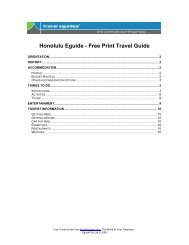Australia Eguide - Travel Guides
Australia Eguide - Travel Guides
Australia Eguide - Travel Guides
Create successful ePaper yourself
Turn your PDF publications into a flip-book with our unique Google optimized e-Paper software.
224<br />
Western <strong>Australia</strong><br />
Western <strong>Australia</strong> covers 2,529,880 square kilometres and is the largest state in <strong>Australia</strong>.<br />
what cannot be denied is the remoteness of this state. It is separated from any other<br />
centres of population by the Nullarbor Plain in the south, by deserts in the centre and by<br />
rugged terrain in the north. Only in recent years has there been a sealed road from<br />
Western <strong>Australia</strong> to anywhere at all. Prior to that, hundreds of kilometres of pot-holed<br />
dirt had to be negotiated to enter or leave the state by road, although the railway has<br />
provided a link for nearly a century now.<br />
Probably Western <strong>Australia</strong> was the first part of this continent to be inhabited by humans.<br />
The aborigines seem to have arrived in the north-west about 55,000 years ago and moved<br />
gradually across the continent from there. The first Europeans to come here were the<br />
Dutch. They discovered that the best route to Batavia ( Jakarta ) was to sail east from the<br />
southern tip of Africa and then turn north. In 1616, Dirk Hartog sailed too far east before<br />
turning north and found the northern part of what is now Western <strong>Australia</strong>.<br />
He landed near Shark Bay at Cape Inscription and left a pewter plate nailed to a tree with<br />
an inscription recording his visit. 81 years later, in 1697, Willem de Vlamingh was<br />
skillful enough to be able to navigate to exactly the same place and retrieve the plate,<br />
which is now in the Rijksmuseum in Holland, leaving another in its place, which is now<br />
in the Maritime Museum in Fremantle.<br />
The first Englishman to pass this way was William Dampier in 1688, but it was not until<br />
1791 that Britain claimed this part of the continent, when Commander George Vancouver<br />
hoisted the British flag at Possession Point, near Albany. The British were concerned that<br />
the French might attempt to found a colony in this area, so in 1826, Darling, the<br />
Governor of New South Wales, dispatched Major Lockyer to Albany in the brig Amity<br />
with a total of 44 men, including 23 convicts, to establish a settlement and pre-empt any<br />
similar French move.<br />
In 1827, the Swan River was explored by Captain James Stirling and there was<br />
discussion as to whether to establish the major settlement at Albany or on the Swan<br />
River. Eventually the decision went in favour of the Swan River and on 2nd May 1829<br />
Captain Charles Fremantle established the new Swan River Colony.<br />
It was intended that this should be a state for free settlers, but the temptation to import<br />
convicts to ease the burden of clearing land proved too great and transportation to<br />
Western <strong>Australia</strong> started in 1850 and continued until 1868. 9,718 convicts were brought<br />
to the colony, out of a total population in 1869 of 23,000.<br />
It was the discovery of gold in the 1880s which changed the fortunes of Western<br />
<strong>Australia</strong>. The first find was in Halls Creek in the far north, but soon further discoveries<br />
were made in the south of the state, culminating in the gold rush in Kalgoorlie in 1893.<br />
Kalgoorlie has been producing gold ever since. Other minerals are produced in Western<br />
Free from <strong>Travel</strong><strong>Eguide</strong>s.com Online <strong>Travel</strong> Information.<br />
©2008 <strong>Eguide</strong> Pty Ltd




